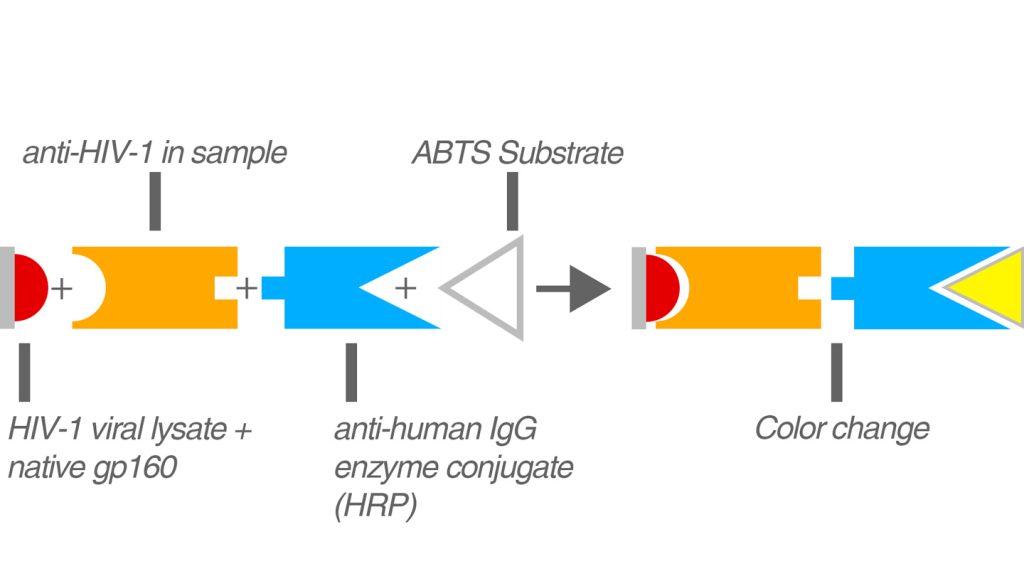Avioq® HIV-1 Microelisa System

Derived from purified and inactivated HIV-1 viral lysate proteins, the Avioq HIV-1 Microelisa System is an enzyme-linked immunosorbent assay (ELISA) for the qualitative detection of antibodies to HIV-1 (a leading causal agent of AIDS in the U.S.) in human specimens collected as serum, plasma, dried blood spots, or oral fluid specimens obtained with the OraSure® HIV-1 Oral Specimen Collection Device.
The Avioq HIV-1 Microelisa System is intended for use as an aid in diagnosis of infection with HIV-1. It is not intended for use in screening blood donors. Developed as a standard two-step indirect microelisa system assay, the Avioq HIV-1 Microelisa System contains coated 96-well microwell plates, color-coded, liquid calibrator and positive control, and a ready-to-use liquid substrate. The sample diluent contains sample addition monitoring to allow visualization of color change upon sample addition to microwells.
Confidence in Results
Color-coded reagents with sample addition monitoring
Excellent performance characteristics to provide the “Right Answer Sooner”
Excellent performance characteristics to provide the “Right Answer Sooner”
Ease of Use
Fast, convenient procedure suitable for automation
No sample pre-dilution step
Color-coded calibrator and positive control
Sample addition monitoring
No sample pre-dilution step
Color-coded calibrator and positive control
Sample addition monitoring
Time & Cost Savings
Excellent sensitivity and specificity in clinical trials providing reduced cost for confirmatory testing
High correlation between initial and repeat
duplicate results
High positive predictive value that saves unnecessary confirmatory testing
Direct dilution into microplate well
High correlation between initial and repeat
duplicate results
High positive predictive value that saves unnecessary confirmatory testing
Direct dilution into microplate well
Technology
Kit Configuration
Test Principle
Literature
Technology
Derived from purified and inactivated HIV-1 viral lysate proteins, the Avioq HIV-1 Microelisa System is an enzyme-linked immunosorbent assay (ELISA) for the qualitative detection of antibodies to HIV-1 (a leading causal agent of AIDS in the U.S.) in human specimens collected as serum, plasma, dried blood spots, or oral fluid specimens obtained with the OraSure® HIV-1 Oral Specimen Collection Device.
The Avioq HIV-1 Microelisa System is intended for use as an aid in diagnosis of infection with HIV-1. It is not intended for use in screening blood donors. Developed as a standard two-step indirect microelisa system assay, the Avioq HIV-1 Microelisa System contains coated 96-well microwell plates, color-coded, liquid calibrator and positive control, and a ready-to-use liquid substrate. The sample diluent contains sample addition monitoring to allow visualization of color change upon sample addition to microwells.
Kit Configuration
The product is available in three kit configurations, the 384, 960, and 9600 test kits. Please refer to the ‘Literature’ tab for additional information, as well as the performance characteristics of this product. The Package Insert is available on the Support menu tab.
Test Principle

The Avioq HIV-1 Microelisa System uses HIV-1 antigens, including inactivated, purified HIV-1 viral lysate proteins, which are coated on the wells of microwell plates, for the detection of antibodies against HIV-1. Upon addition of a diluted test specimen containing antibodies to HIV-1 to a microwell, immune complexes are formed through the interaction between the anti- HIV in the specimen and the HIV antigens coated on the microwell.
Following incubation, the specimen is aspirated and the well is washed with buffer. Subsequently, anti-human immunoglobulin (goat) conjugated with horseradish peroxidase (HRP) is added which binds to the anti-HIV antigen complex during a second incubation. Following a wash and incubation with ABTS (2,2’-azino-di-(3-ethylbenzthiazoline-6-sulfonate)) substrate, a green color is produced. The enzyme reaction is stopped by the addition of a fluoride solution.
The amounts of antibodies to HIV present in the specimen are qualitatively proportional to color intensity. Because of the use of HIV-1 viral lysate as the primary antigens in the test, significant cross-reactivity with HIV-2 specimens was observed.
Literature
